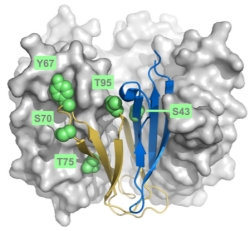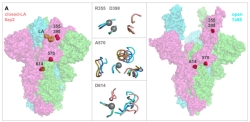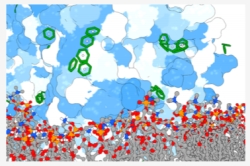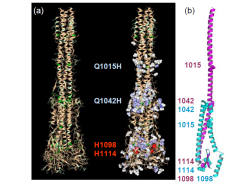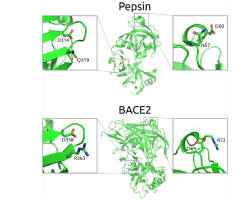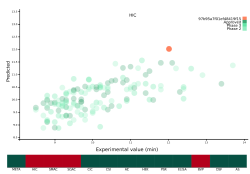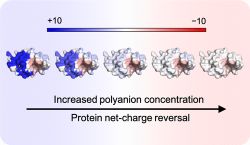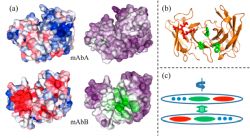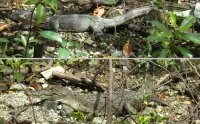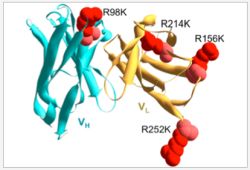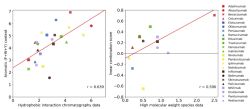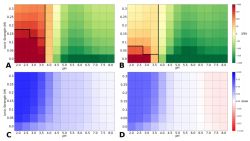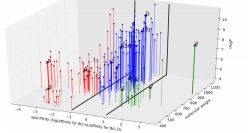 |
Warwicker Group
|
  |
|
News
Nov 2017: Nick Fowler has impressively pulled together his collaborating Supervisors to publish a model (in Chemistry) for predicting reduction potentials of copper proteins, combining continuum electrostatics and density functional theory. Oct 2017: Jim spoke at the Bioproduction conference, in Dublin. Oct 2017: Stefan Ivanov and Andrew Cawley were the lead workers in our study of protein-protein interaction specificity between families of protein paraloges, published in PLoS One. We find that a large degree of specificity arises from modulation of charge interactions, on top of the steric scaffold. Sep 2017: Nick Fowler attended a conference on QM/MM methods, in Manchester. Sep 2017: Max Hebditch's computational work predicting a link between the IDP properties of antibody CH1 domains, and some with other IgSF domains has been published in Sci Rep. Jul 2017: James Baker's analysis of charge residue location in and around transmembrane segments has been published in BMC Biology. This joint work with Frank and Birgit Eisenhaber's groups reveals a "negative outside" feature to add to the "positive inside" rule. May 2017: A description of our tool for prediction of protein solubility has been published in Bioinformatics, with Max Hebditch the lead author. Jun 2017: Jian Lu's group has published a neutron refection study of mAb and Fab, Fc surface adsorption, to which our group made a small contribution. May 2017: A description of our tool for prediction of protein solubility has been published in Bioinformatics, with Max Hebditch the lead author. Apr 2017: We welcomed Frank Eisenhaber from the Bioinformatics Institute in Singapore (and James Baker's A*STAR Supervisor), for a talk, subsequent to a meeting of A*STAR associated researchers in Sheffield. Mar 2017: The bioprocessing group's scFv work is online, with James Austerberry as the first author who drove through a combination of various strands in this piece of work. Dec 2016: Spyros Charonis defended his PhD in a viva with Sam de Visser and Chris Roberts. Congratulations to Spyros, more material to publish from the PhD. Nov 2016: We attended a symposium celebrating 10 years of the MIB. Oct 2016: The scFv mutants designed at Manchester, and central to work lead by James Austerberry here, have also been used in now published work by Alex Jones in Colin Robinson's group, furthering their analysis of the TAT system in E. coli. Oct 2016: Jim attended the BioProNet annual meeting in Nottingham. Oct 2016: Max Hebditch gave a talk at a conference on the biophysical characterisation of proteins in Palermo. Oct 2016: Stefan Ivanov has returned to our group following his 2 years at the BII, with Pete Bond's group, in the A*STAR PhD programme. Stefan's return coincided with publication of his nice work on binding specificity within the Bcl-2 family of proteins. Jul 2016: Nick Fowler and Jim Warwicker attended the Berlin meeting on protein electrostatics, organised largely by Walter Knapp. Great to have a mixture of younger and older hands considering where this field moves on to next, other than Telluride in 2017. Jun 2016: The results of a long-standing collaboration with the groups of Mark Boyett and Tom Claydon have been published, looking at the synergy between pH, certain charged groups, and polyunsaturated acids on Kv1.4 channel activity. May 2016: Jim Warwicker and Robin Curtis are the Manchester end of an EPSRC award, 'Enabling rapid liquid and freeze-dried formulation design for the manufacture and delivery of novel biopharmaceuticals', with Paul Dalby (PI) and Ajoy Velayudhan at UCL. Apr 2016: This is probably the last of our visits down to UCL for a 'talks day' at Spyros Charonis' cohort of the EPSRC CDT. Other than the excellent interdisciplinary programme at these days, it is also worth noting the proximity of the British Library to UCL and Euston, and the possibility of a tea-room visit next to old books. Apr 2016: We said goodbye to Alejandro Carballo after 5 entertaining years in total (4 yr PhD joint with Alan Dickson and 1 yr PDRA) in Manchester, working on experimental and in silico analysis of protein solubility. There is plenty of work coming through from this time, of which our solubility prediction server is just one example (and thanks also to Max Hebditch and Spyros Charonis). Mar 2016: Jim Warwicker and colleagues attended the Biopharmaceutical Analytical Group meeting in Darlington, using the opportunity of this talk to mention our fledgling protein solubility prediction server. Although in its preliminary stages, it still represents a substantial amount of work, from Max Hebditch, Spyros Charonis, and Alejandro Carballo (the latter being support by a BioProNET Proof of Concept award). Feb 2016: Richard Henchman and Jim Warwicker have been awarded a PhD position, for collaboration with Paul Dalby (UCL) at an EPSRC-funded CDT (Emergent Macromolecular Therapy). Dec 2015: Rose Keeling (Curtis and Warwicker groups) has successfully defended her PhD viva, examined by Alain Pluen and Thomas Croguennec, (minor revisions were subsequently signed off), well done Rose! Rose is now spending some time at MedImmune, who jointly sponsored (with BBSRC) her PhD. James Gilburt (Robin Curtis and Jeremy Derrick groups) started and finished his PhD contemperaneously with Rose, also completing successfully and now at Imperial. Oct 2015: James Baker has completed the first year of his PhD in Manchester, and journeyed to the Bioinformatics Institute (BII) in Singapore to carry on the PhD with Frank and Birgit Eisenhaber. He will return to Manchester for the fourth and final year of his PhD. James joins Stefan Ivanov (currently in the third year of his PhD, jointly supervised by Peter Bond at the BII). We are all looking forward to productive collaborations, and much Skyping! Oct 2015: There was a substantial Manchester presence at the back to back BBSRC BRIC and BioProNet meetings at the Manchester Midland Hotel, the latter meeting coincident with (but a few 100m away from) the Chinese President's visit to Manchester. Rose Keeling gave the close-out talk for her completed PhD (joint with MedImmune), which received a presentation award, and Alejandro Carballo gave an update on our solubility web tool project. A short while prior to these conferences, Rose had presented at the Society of Rheology annual meeting in Baltimore. Oct 2015: Jim has completed his 4 year appointment as External Examiner for the Glasgow Bioinformatics, Polyomics and Systems Biology MRes, and his 8 years plus as MSc Bioinformatics and Systems Biology course director in Manchester. Best wishes to Mark Bailey in Glasgow for his course, and to Jean-Marc Schwartz, taking over the Manchester MSc. Sep 2015: Luke Holloway (iCASE student with Robin Curtis, and Shahid Uddin, Chris van der Walle at MedImmune) has relocated to Cambridge for a placement in the MedImmune formulation group. Although Luke is not specifically part of this Manchester-MedImmune collaboration, his work is related. May 2015: Fresh from his PhD award, Alejandro Carballo joined us on a 9 month Proof of Concept project, funded by the BioProNet BBSRC NIBB. Our aim is to deliver to the web, the various solubility-related tools that we have published or are in development. Jun 2015: More UKIERI work has been published, combining pH-dependence and domain swapping, by Prashant Shingate, working in Prof Sowdhamini's group in Bangalore. May 2015: James Baker and Nick Fowler gave talks at a Symposium for PhD students in the CEB research grouping in the Faculty of Life Sciences in Manchester. Apr 2015: Spyros Charonis talked at UCL, in a meeting around the EPSRC CDT that funds his PhD. Another contribution to collaborative work (Finbarr Hayes' group) has appeared in print: Breaking and restoring the hydrophobic core of a centromere-binding protein. It was particularly satisfying to see Ivan Sazanavets' work on the computation of ion channel pH-dependence published, following his PhD defence earlier in the year: Computational tools for interpreting ion channel pH-dependence. Feb 2015: It was nice to see our UKIERI award with Bangalore see work published from Sumanta Mukherjee in Nagasuma Chandra's group: Deciphering complex patters of class-I HLA-peptide cross-reactivity via hierarchical grouping. Nov/Dec 2014: Robin Curtis' group added another Mol Pharm publication: Specific ion and buffer effects on protein-protein interactions of a monoclonal antibody. continuing collaboration with the formulation group at MedImmune, whilst JW's group saw publication of a couple of other collaborative contributions (with Jeremy Derrick's and Donald Ward's groups): Structure and mechanism of the bifunctional CinA enzyme from Thermus thermophilus. Pathophysiologic changes in extracellular pH modulate parathyroid calcium-sensing Receptor activity and secretion via a histidine-independent mechanism. Oct 2014: The group (with Robin Curtis' lab) have welcomed three new PhD students: James Baker on a Manchester - A*STAR PhD project with Frank and Birgit Eisenhaber's group at the BII. Nick Fowler is a joint student Sam de Visser's computational enzymology group, and Chris Blanford's group, whose work includes bioelectrocatalysis, the subject of Nick's PhD. Luke Holloway is a BBSRC iCASE student with Robin Curtis, and with the formulation group at MedImmune (in particular Shahid Uddin and Chris van der Walle). Jim Warwicker attended the BioProduction meeting Barcelona, an excellent event at which JW was not the only visitor from Manchester, apparently. Several group members attended the BBSRC/BRIC Dissemination and BioProNet first annual meetings at Cardiff waterfront. Sep 2014: Rose Keeling and Max Hebditch will be attended the Neutrons in Biotechnology conference, 3 - 5 September, in Abingdon. Stefan Ivanov departed for holiday, then transit to BII, SIngapore to continue his A*STAR PhD project, for which we had a lab lunch, but unfortunately not pictures. July 2014: Keeping us on our toes for Manchester landmark venues, COEBP organised a formulation meeting (15 July) at MOSI (a wonderful museum), which several group members attended, along with the meeting on the following day organised by the KTN Biopharmaceutical Formulation Group. Stefan Ivanov attended a Drug Discovery workshop in Oxford (21-25 July), with the emphasis on small molecules rather than than the biologics that have become a focus in the group. Spyros Charonis attended one of the schools organised by his PhD network, the UCL CDT. For 8-11 July, Jim Warwicker enjoyed the hospitality of Antonio Baptista and colleagues in Lisbon at a European protein electrostatics meeting, organised as a complement to the excellent Telluride electrostatics meetings. Alejandro Carballo attended the Protein Society Symposium in San Diego, from 27-30 July, still one of the best forums for discussing all things Protein. July also saw the Curtis group continue with publication of work in the area of protein and biologic solubility and aggregation, with the author line reflecting the close collaboration with our colleagues at MedImmune, Cambridge. The role of electrostatics in protein-protein interactions of a monoclonal antibody. June 2014: Rose Keeling has extended her (BRIC) PhD links with MedImmune, through a spell working at the MedImmune, Gaithersburg laboratories, coupled with a data gathering visit to NIST. Several of us attended a sandpit meeting on 4-5 June for BioProNet, a BBSRC/EPSRC funded network in Bioprocessing, which although local (Manchester), opened us up to the delights of the Manchester landmark Palace Hotel. March 2014: Continuing our interest in modelling pH-dependence (for ion channels in this case), undergraduate project student Ben Nathanson has been immersed in protein structure modelling, and submitted his report. March 2014: Our groups (Curtis and Wawicker) were represented at the Spring BBSRC/BRIC Dissemination event 13-114 March in Glasgow. February 2014: We have published a couple of studies into protein solubility and aggregation, both computational, one dealing largely with protein solubility in over-expression and one with protein solubility subsequent to expression: Soluble expression of proteins correlates with a lack of positively-charged surface. Lysine and arginine content of proteins: computational analysis suggests a new tool for solubility design. Both of these publications are open access, the first through BBSRC support of Pedro Chan's PhD, and the second owing to the contribution of Spyros Charonis, undertaking an EPSRC-funded PhD via a Doctoral Training Centre at UCL. This is hopefully just a start in the area of linked computational and experimental protein solubility studies, that several members in the Curtis, Warwicker, and other collaborating academic and industrial groups, are pursuing. February 2014: Our PhD students continue to benefit from the various interleaved schemes that their studentships involve. Thus, Rose Keeling is currently on an extended visit to our Industrial collaborator, MedImmune, Cambridge, in the formulation group, with Shahid Uddin and Malgorzata Tracka. Spyros Charonis has a training course, delivered by the UCL hub of the CDT scheduled for later in February. January 2014: Ivan Sazanavets has left the lab for 'omics data processing employment. We are preparing work for publication based on Ivan's PhD. Stefan Ivanov enjoyed (so we are led to believe) the CCPBioSim multiscale modelling conference in Manchester (well next door to us at the MIB really, we're cheap). December 2013: Spyros attended the 10th Annual BioProcess UK conference in London. The 2014 version is due to be in LIverpool. November 2013: We currently have two specific PhD projects being advertised under separate University of Manchester schemes. The A*STAR project is joint with with Frank and Birgit Eisenhaber at BII, Singapore. The Manchester project is joint between our School of Life Sciences group and those of Sam De Visser (Chemical Engineering) and Chris Blanford (Materials Science). Three different Schools, but actually our offices are next to eachother in the MIB! Deadline for the DTP project is 6 December. More information from the FLS PhD study web pages or from me. November 2013: Spyros Charonis attended a couple of events outside of Manchester recently, a training meeting at the UCL hub of the EPSRC CDT that funds the PhD, and a Biotechnology YES workshop at BioCity Scotland. Rose Keeling has been part of a BBSRC/BRIC Skills School at Eden Biodesign. September 2013: Well, that's something of a gap. Our group along with that of Robin Curtis, has been preparing work for submission/publication in a key area for us, protein solubility and aggregation. In the meantime several collaborations (with the groups of Steve High and David Leys) in other areas have been published:
With the changeover of academic years, we have said goodbye to undergraduate project students, Nurul Borhan, Andrej Gnip and Esther Fagnano. We have also said goodbye to Dorota Roberts, moving on from a joint BBSRC project with the groups of Robin Curtis and Jeremy Derrick. We welcome incoming PhD students Stefav Ivanov and Max Hebditch, both in collaborations, Stefan in the area of specific protein-protein interactions and Max generally in non-specific protein-protein interactions. January 2013: We received the news of Andrew Grant's passing away over the holiday period. Andrew, who worked at AstraZeneca, Alderley Park, was a very good friend to the group over the years, and was (current PhD student) Ivan Sazanavets co-supervisor. We will miss him very much, for his science and for his personality and friendship. Andrew's long time collaborator, Anthony Nicholls of OpenEye software has written an appreciation. Andrew was External Examiner for Salim Bougouffa's PhD; Salim writes, "I knew he was a really nice man from the genuine smile he had throughout the viva". That's not usual Examiner behaviour! December 2012: December graduation was fun again, with the MSc Bioinformatics and Systems Biology class graduating, and often a PhD student well known to our group. This December Andrew Cawley graduated, himself a graduate of the Bioinformatics MSc, some years ago. November 2012: We currently (deadline early December 2012) have two specific PhD projects being advertised under separate University of Manchester schemes (one joint with with Chandra Verma at BII, Singapore). More information from the FLS PhD study web pages or, of course, from me. October 2012: We have two undergraduate project students for the coming year. Andrej Gnip wiill be looking at potassium channel bioinformatics, in the mould of Binbin Liu's paper but more widely in the superfamily. Nurul Borhan will be helping us to test our solubility prediction software, with computational work translated to testing in Alan Dickson's lab, working with PhD student Alejandro Carballo. October 2012: Spyros Charonis has submitted his Masters thesis and commenced a PhD with Robin Curtis and Jim Warwicker, on computational modelling of protein solubility. This PhD is funded by EPSRC and is part of a UCL centre in emerging macromolecular therapies. October 2012: Two PhD students from Professor Srinivasan's group in Bangalore have arrived for a 2 month visit to our group (Raksha) and those of Simon Lovell and David Robertson (Sudha). This almost closes out the UKIERI funded exchanges that have been so useful over the last 4 years. October 2012: Jim has finished enjoyable stints as External Examiner for Masters degrees in Applied Bioinformatics at Cranfield, and in Molecular Biophysics at KCL. Thanks to Mark Sanderson, Roberto Steiner and Brian Sutton for hosting me at KCL. I've seen this next door neighbour spring up in the last few years. September 2012: Another year of our MSc in Bioinformatics and Systems Biology has passed, fun as usual, with 4 of our students undertaking summer projects in the Cambridge area (EBI and Sanger). In other project work, my group had the pleasure of working with Muxin Gu (now a PhD student in Catherine Millar's group), and Madikay Senghore. September 2012: Andrew Cawley's article on protein-mRNA interactions, with a genomic perspective, is out in NAR. We managed to get "polyelectrostatic" in the title! July 2012: Andrew Cawley's PhD viva (successful) coincided with Pedro Chan's graduation day (enjoyable). May 2012: Jim attended the Prague Protein Spring meeting, an excellent few days of 'protein discussions'. April 2012: Jim spoke at the 5th Annual Proteins Congress in London, presenting our work on protein solubility prediction. March 2012: A contigent from Manchester attended and presented at the Spring BBSRC/BRIC dissemination meeting in Leeds. February 2012: It was a pleasure to host Nagasuma Chandra's visit through Manchester, part of our UKIERI exchange programme. January 2012: Rose Keeling is spending some months at MedImmune, Cambridge (the Industrial partner for Rose's project in the BBSRC/BRIC scheme), learning the ropes in their Formulation group. November 2011: A BBSRC/BRIC funded project to Robin Curtis, Jeremy Derrick, Alan Dickson and JW, "Understanding and predicting aggregation in biopharmaceuticals", is just starting. October 2011: A BBSRC/BRIC funded PhD student, Rose Keeling, is commencing a industrial-linked project, supervised at the Manchester end by JW and Robin Curtis. September 2011: Allied to the efforts of the (not necessarily only protein) pKa coop, various of the groups involved are now publishing their results of predictions of pKas in SNase mutants (Bertrand Garcia Moreno group). Our own is here, and there is also a 'combo' article. July 2011: Pedro Chan has been PhD viva-ed, assessed for minor corrections, and subsequently approved. Congratulations! July 2011: Andrew Cawley and Ivana Sazanavets attended the Vienna ISMB meeting, with many Manchester colleagues and also with members of the partner groups on our UKIERI funded award for joint work in the area of protein complexes. June 2011: Joint work with Pawel Leznicki and Steve High implies a perhaps surprising ability of tail anchor segments to drag PEGylated chains partially into a membrane. June 2011: As part of our move to add protein solubility prediction to the various charge-related algorithms that we have helped develop, Jim spoke at Informa Life Sciences conference on Non-Antibody Protein Production, in Berlin. April 2011: Jim Warwicker has able to put faces to names for many colleagues in the 'protein electrostatics and pKa prediction' field after a meeting organised by Emil Alexov at Clemson University. January 2011: Alejandro (Alex) Carballo has joined us as a PhD student, jointly with Alan Dickson's group, helping us to look at structural bioinformatics and protein solubility, testing predictions. December 2010: The December Graduation ceremony is always a good time, with our MSc Bioinformatics 2009/10 class, and PhD students. This year Salim Bougouffa and Tracey Bray received their PhDs. October 2010: Tracey Bray's PhD viva came in at a hefty 5 hours, but the Examiners's recommendation went the other way - no corrections! October 2010: Collaborative work on eIF4E / 4E-BP appears in this paper from John McCarthy's group. September 2010: Welcome to the new MSc Bioinformatics group, the last under that course name, from 2011 the course reflects the changing landscape: MSc Bioinformatics and Systems Biology. August 2010: All change for the group, as Tracey Bray puts the finishing touches to her PhD thesis, Mitra and Harish complete their studies, and Pedro Chan is also writing up his PhD. And we move from the Michael Smith building to the Manchester Interdisciplinary Biocentre, 71 to 16 on this map. July 2010: The lab hosted a 1 month placement for local student Lucy Hall, funded by the Nuffield Foundation Science Bursaries. June 2010: Jim Warwicker enjoyed a visit to Graham Kemp's group at Chalmers University in Gothenburg, for a Licentiate review. May 2010: MSc Bioinformatics students Mitra Kabir and Harish Prabhaharan will be joining the the lab for their long (summer) projects. April 2010: Tracey Bray and Jim Warwicker attended a meeting at King's College, London on Biological Interfaces, organised by the Thomas Young Centre. An excellent day and a half of talks and discussions. April 2010: Pedro Chan's attendance at RECOMB-2010 has been disrupted by the volcanic ash cloud. This organisers have rescheduled this conference for August 2010.. April 2010: Ivan Sazanavets will be joining us in Autumn 2010, to take up the CASE PhD studentship (with Andrew Grant of AstraZeneca). Rather than coming to the Michael Smith building, Ivan will be joining us in our new environment, the MIB, following a planned Summer 2010 move. March 2010: An application for WT VIP funding has been awarded, allowing Pedro to work over the summer on the bioinformatics of specificity in the recognition of transmembrane helices, in collaboration with the labs of Steve High and Blanche Schwappach. March 2010: Jim took part in Andrey Karshikoff's Graduate student course, at the Karolinska Institute in Stockholm. Andrey hosted impeccably, and included a free tour of his snow-induced roof collapse. February-April 2010: MSc Bioinformatics students, Dave Lee and Mike Nelson were welcomed in our lab, for their short projects. Dave has been comparing DNA-protein and protein-protein interactions, and Mike studying complementarity and hetero-oligomerisation in a family mitochondrial chaperones, in collaboration with Hui Lu. November 2009: Tracey Bray's paper comparing site prediction tools is published. Here is our SitesIdentify tool. October 2009: Pedro Chan's paper on protein adaptation to subcellular pH is published in BMC Biol. Pedro also has a nice colour PDB by conservation tool, currently under test. James Kitchen's PhD is now finished and hard-bound, sitting in the lab as a shining example ... September 2009: Both James Kitchen and Salim Bougouffa have been PhD viva-ed September 2009: Jim attended Andrey Karshikoff's 2009 "Sofia Protein Science Workshop", a 'charged' event, with such luminaries as Andrey himself, Bertrand Garcia-Moreno and Emil Alexov. July 2009: Tracey Bray attended the 2009 ISMB and 3DSIG meetings in Stockholm. June 2009: A CASE PhD studentship is available in our laboratory, joint with Andrew Grant at the Alderley Park site of AstraZeneca. More details are available. June 2009: James Kitchen and Salim Bougouffa have submitted their PhD theses for examination. James is now in Robin Allaby's group at Warwick HRI. May 2009: Nidhi and Swapna are giving talks to the Manchester Bioinformaticians today (Thurs 21). We eagerly await the talks and the cake, made by Tracey Bray. Do we dare eat it? March 2009: PhD students Ms Seshadri Swapna and Ms Nidhi Tyagi start a 2 month visit to the Warwicker and Lovell laboratories in Manchester, from Professor Srinivasan's group, and funded by UKIERI. March 2009: James Kitchen visits Professor Srinivasan's Lab at the Indian Institute of Science, Bangalore, funded by a 3 year award from UKIERI. March 2009: Publication of Tracey Bray's first paper, in J Mol Biol: Sequence and Structural Features of Enzymes and their Active Sites by EC Class. PubMed March 2009: Publication of work with Richard Greaves on possible stabilising sugar binding sites in extremophile proteins: Stability and solubility of proteins from extremophiles. PubMed October 2008: Andrew Cawley starts his PhD in the group, combining the work of writing up PhD students James Kitchen and Salim Bougouffa. October 2008: Publication of Salim Bougouffa's first paper, in BMC Bioinformatics: Volume-based solvation models out-perform area-based models in combined studies of wild-type and mutated protein-protein interfaces. PubMed March 2008: Publication of James Kitchen's first paper, in BMC Structural Biology: Charge environments around phosphorylation sites in proteins. PubMed |
|||||||||||||||||||||||||||||||||||||||||||||||

